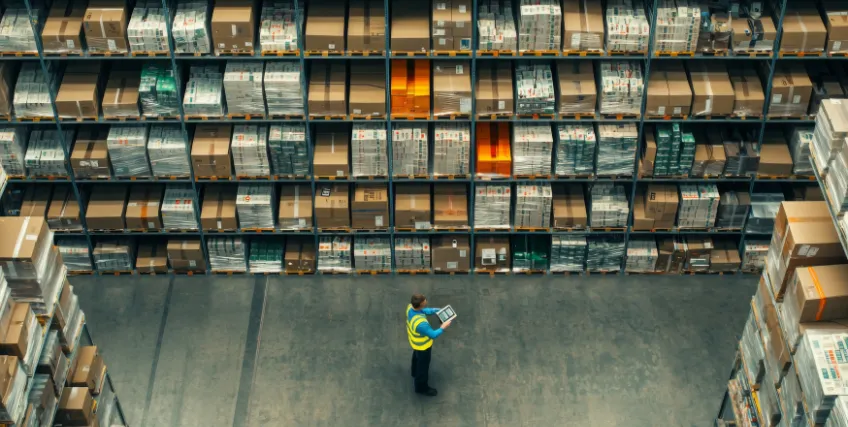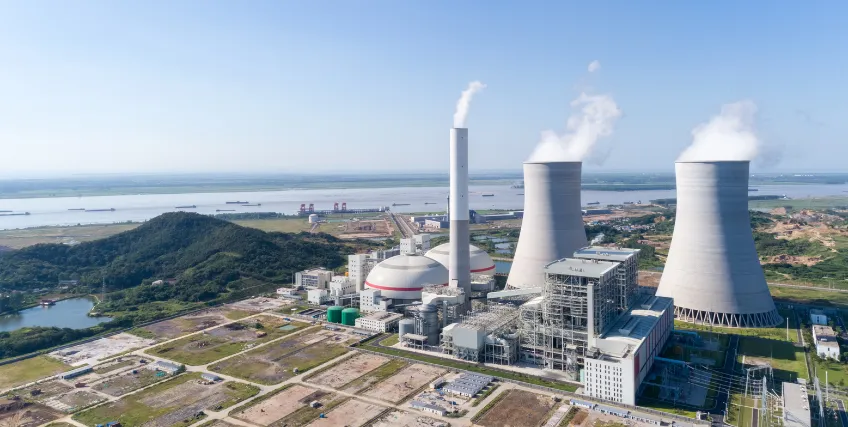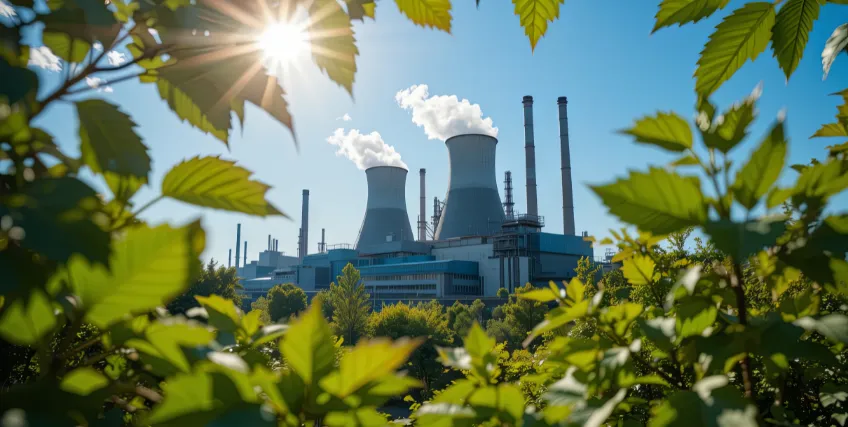What Is a Commercial and Industrial Loan: A Guide for Business Owners
October 28, 2025 | Last Updated on: October 28, 2025

As said, “big machines, bigger responsibilities”. Thermal power plants require intensive working capital to keep things running smoothly. These systems need to be efficient and compliant with evolving regulations which require more than just technical expertise. It demands consistent access to funding that aligns with the unique financial rhythms of energy production.
One effective solution for such business needs is a Commercial and Industrial (C&I) loan. These loans provide flexibility, scale, and structure that align with the unique challenges thermal power operators face. Whether it’s boosting working capital, acquiring advanced machinery, or meeting sudden cash flow gaps, a C&I loan can make all the difference.
In this article, we’ll discuss what C&I lending is, explore different types of C&I loans, outline eligibility requirements, and explain how business owners can apply these loans to real-world energy operations.
What Is a Commercial and Industrial Loan?
A Commercial and Industrial loan is a form of business financing designed for entities such as corporations, partnerships, or sole proprietorships. Unlike commercial real estate loans, which are tied to property, C&I loans are typically secured through business assets like accounts receivable, inventory, or equipment.
For a thermal power plant, C&I lending means accessing structured financing to fund emission controls, system upgrades, and capacity-building without liquidating other assets. This type of C&I loan is commonly used to support:
- Equipment and fuel purchases
- Plant expansion
- Hiring and operational expenditures
- Covering seasonal shortfalls in cash flow
- Managing bulk fuel costs and utility contracts
Why Do Thermal Power Plants Need C&I Loans?
Now the most important question: why do thermal power plants need C&I loans? The answer is that thermal power plants rely on massive infrastructure that requires routine capital injections. According to the U.S. Energy Information Administration (EIA) 2024, thermal energy continues to supply the majority of electricity in several regions globally. However, to maintain this output, thermal power plants require constant equipment servicing and investment in newer & efficient technologies.
Let’s say a thermal power plant is looking to replace its outdated turbine system with a high-efficiency model to lower emissions. For this, the power plant would require necessary funds through C&I loans for upgrading the equipment. This financing solution will allow the small business owners to repay in installments and help them protect the business’s liquidity while meeting regulatory requirements at the same time.
Types of C&I Loans for Thermal Businesses
Here are some types of C&I loans available so that business owners can select the right financing solution according to their needs.
- Term Loans: Term loans offer a lump sum of amount that is repaid over a fixed period of time with a fixed interest rate. These loans often come with a fixed repayment schedule and are ideal for large project funding, expansions, and fuel system overhaul.
- Lines of Credit: Business lines of credit offer a revolving amount up to a predestined limit. Business owners can withdraw necessary funds when needed and pay interest only on the amount used. These loans are best for funding short-term fuel purchases or emergency repairs.
- Equipment Financing: If your thermal power plant requires machinery or any sort of equipment, these equipment loans can be the right choice. Here you can purchase the equipment without paying any upfront cost, where the equipment itself serves as collateral.
- SBA Loans: SBA loans are government-backed loans offered by the U.S. Small Business Administration. These loans offer favorable interest rates with longer repayment terms; however, the application process is a bit lengthy and stringent at the same time. SBA 7(a) and SBA 504 loans can be used for funding thermal power plant projects.
Key Benefits of C&I Loans in Thermal Power Plants
The right financing solutions support thermal power plants for long-term growth. In particular, C&I loans offer more than just capital. They provide structured solutions that align with your plant’s operational, regulatory, and strategic needs.
The top benefits of using C&I loans for thermal power plants include:
Support for Essential Business Purposes:
C&I loans are designed to serve a wide range of business purposes. These can be used in thermal power plants for upgrading turbine systems, investing in pollution controls, or managing higher fuel costs during peak seasons. Moreover, C&I loans ensure you have the funding when it's needed most for your business.
Flexible Loan Options to Match Project Demands
These loans offer flexibility from short-term credit lines to long-term business loans, providing multiple loan options. This flexibility allows thermal power plant business owners to choose a structure that suits the size and timeline of their project.
Preserves Business Ownership
Unlike equity-based financing, a C&I loan for a thermal power plant does not require you to give up shares in your company. Instead, you retain full control over operations while still accessing the capital needed to grow. This is especially important for small business owners who want to scale without sacrificing autonomy of their business.
Predictable Repayment Structure
These loans come with clearly defined repayment terms and a set repayment schedule. This brings predictability to your cash flow and enables better financial planning. Additionally, it protects your business from the strain of irregular or balloon payments.
Opportunities to Build Credit
By making on-time repayments, you can significantly improve your credit score and demonstrate creditworthiness to future lenders. Over time, this can open doors to larger business loans or lower interest rates, which is crucial if you're planning multiple projects or need recurring capital access.
Competitive Interest Rates
Compared to high-interest alternatives like merchant cash advances, C&I loans often feature more favorable interest rates, especially if backed by collateral or offered through financial institutions or credit unions with industry experience.
Improved Cash Flow and Liquidity
Instead of draining your reserves, C&I loans protect your liquidity. You can use them to finance capital expenditures, cover operating costs, or plug short-term gaps in cash flow, all while maintaining financial stability.
Eligibility for a Commercial and Industrial Loan
The eligibility criterion for a C&I loan depends on multiple financial and operational factors. Lenders evaluate a mix of financial health indicators and business background before approving the loan application.
- Credit Score and History: A personal and business credit score above 680 is usually considered favorable. However, lenders may also assess your credit history, payment behavior, and existing lines.
- Financial Information: Lenders typically require comprehensive financial statements, including balance sheets, income statements, and cash flow projections.
- Business Plan: A solid business plan explaining the purpose of the loan, projected ROI, and operational risks improves your loan approval odds.
- Tax Returns: Most lenders request at least 2–3 years of tax returns to verify revenue consistency and creditworthiness.
- Collateral: Depending on the loan type, you may need to offer commercial real estate, equipment, or future earnings as security.
- Legal Status and Ownership: Your business must be legally registered, with up-to-date documentation proving its operational and tax compliance.
Application Process for C&I Loans: Step-by-Step
Here’s how you can apply for a C&I loan, step-by-step.
Step 1: Evaluate Your Needs
The first step is to determine the loan amount you need. Also, make sure how the funds will be used and for what. For example, you can use the funds for equipment upgrades, working capital, or to cover operational gaps.
Step 2: Research Lenders
The second important step is to explore various financial institutions, credit unions, and FDIC-insured banks. It’s better to choose lenders with experience in commercial and industrial lending to the energy sector. Also, make sure to compare the loan options.
Step 3: Prepare Documents
Once you have figured out your lender, gather all important documents containing financial information. These documents include appraisals, tax returns, bank statements, utility bills, licenses, and technical specs of the equipment or project.
Step 4: Submit Loan Application
After gathering all the required documents, fill out the lender’s loan application form. You can fill in the form either in person or online and submit your documentation package.
Step 5: Underwriting and Review
After submitting the loan application form, the lender’s underwriting team will assess your business banking history. They will also go through your risk profile and projected revenue of your business. However, this process may take a few days to several weeks.
Step 6: Receive Loan Agreement
If approved, you’ll receive a loan agreement detailing repayment terms, interest rates, and collateral requirements. Keep in mind to review carefully before signing the loan agreement.
Final Thoughts
In short, thermal power plants do require heavy working capital for their operations. They need to secure the right C&I loans to keep pace with technology, comply with regulations, and expand without depleting essential reserves.
C&I loans can be used to support various business purposes in thermal power plants like buying new turbines and enhancing pollution control systems. With the right type of commercial and industrial loan, small business owners can plan for long-term resilience and profitability for their thermal power plant. Also, these loans offer structured repayment terms, flexible loan options, and support from experienced lenders. Hence, these loan options can address both immediate and future business needs for thermal power plants.
Explore your thermal power plant financing options today and connect with experts who understand energy infrastructure inside and out.
Frequently Asked Questions About C&I Loans
What is the difference between a C&I loan and a commercial real estate loan?
A C&I loan is used for general business purposes like equipment purchases, working capital, and operations, while a commercial real estate loan is specifically used to finance the purchase or development of real property. For thermal power businesses, C&I loans can be used for upgrading and expansions that don’t involve buying land or buildings.
What can a commercial and industrial loan be used for in a thermal power plant?
A C&I loan can be used for a variety of needs in a thermal power plant such as purchasing turbines, upgrading boilers, installing emission control systems, or funding expansion projects. It also supports daily operational costs like fuel procurement and labor.
What documents are needed to apply for a C&I loan?
Documents like tax returns, balance sheets, cash flow statements, a clear business plan, and details about the project or equipment being financed are needed to apply for a C&I loan. Nevertheless, some lenders may also require appraisals or proof of accounts receivable.
Can I use a commercial loan to refinance existing debt on my thermal plant?
Many thermal plant operators use C&I loans to consolidate or refinance high-interest debt. This in turn helps in improving their cash flow and overall financial health. Additionally, this approach can also help secure better repayment terms, reduce monthly liabilities, and free up working capital for critical operations or equipment upgrades.
Are C&I loans available as unsecured loans?
C&I loans typically require collateral, especially for large sums. This collateral might include business equipment, future receivables, or other valuable assets. However, some lenders might offer unsecured loans too.




